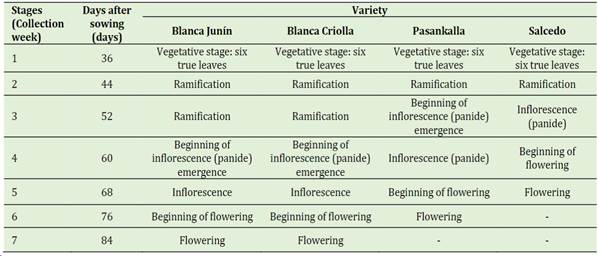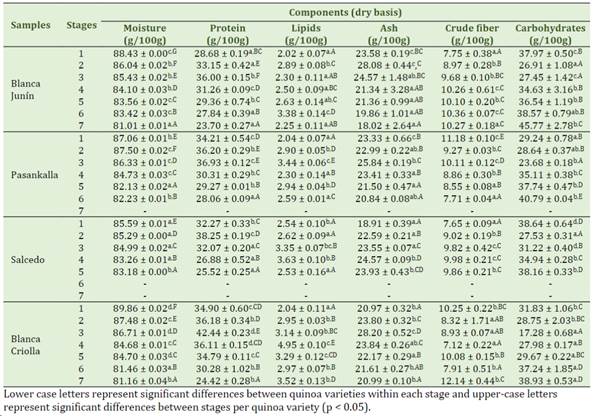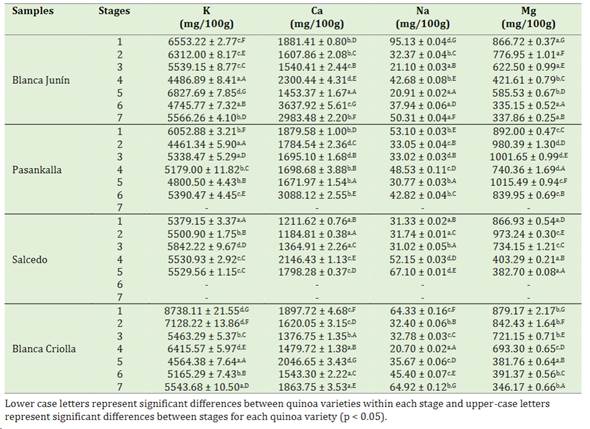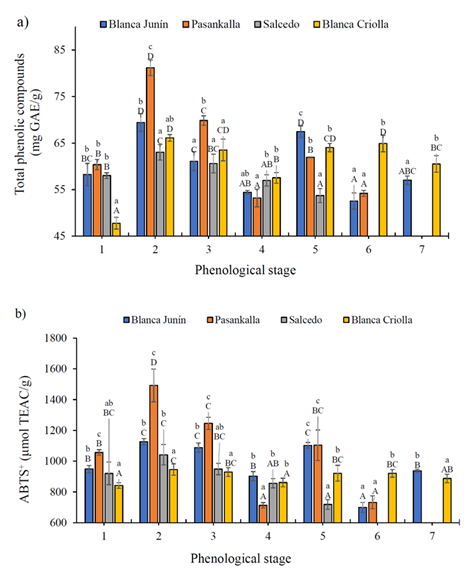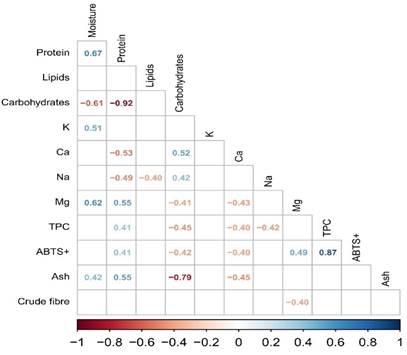INTRODUCTION
Finding new sources of nutrients is important for societies with fast-growing populations. Andean indigenous crops are often neglected despite having a high nutritive value and being easily available for the local people. Some of the crops are cultivated while others are wild and considered as weeds. Quinoa (Chenopodium quinoa) and other native grains, such as kiwicha (Amaranthus caudatus) are mainly cultivated for their grains in Peru for their high nutritional and nutraceutical quality Repo-Carrasco-Valencia et al. (2019). In addition, tender leaves of these crops are used in some communities in the Andes as leafy vegetables in times when there are no other leafy vegetables available. Another amaranth species, Amaranthus dubius, is commonly cultivated as vegetable in certain areas of the Peruvian coast and Andes. The leaves of these crops could be used as a vegetable and as ingredients in different foods, such as bread, thus improving its nutritional value. The consumption of plant products is a fundamental requirement for human well-being and leafy vegetables play a crucial role in this regard, especially for rural populations (Moyo et al., 2013).
Indigenous greens as a general rule have higher nutrient values compared to domesticated green vegetables and could be considered as important food sources in Latin America. Traditional vegeta-bles are readily available in the field and have the potential to contribute to reducing malnutrition in the poor segments of the population by providing resources for food diversification and supplemen-ting the diet. The leafy vegetables are an interesting alternative to be used, for example, as a source of leaf protein concentrates, which could be used in animal and human nutrition. The Dietary Guidelines for Americans recommend consuming 4 to 5 servings of vegetables per day, based on an intake of 2000 calories (Jiménez-Aguilar & Grusak, 2015). Indige-nous greens are rich in dietary fibre, minerals and vitamins. These leafy vegetables are also potentially rich sources of phenolic compounds and other phytochemicals with high antioxidant activity. These compounds can provide protective effects against major diseases associated with oxidative damage (Moyo et al., 2013; Tauchen et al., 2016).
There are few studies about the use of quinoa as a leafy vegetable (Pathan et al., 2019). According to Pathan et al. (2019), the content of protein, amino acids and potassium in quinoa leaves is higher than that found in amaranth or spinach. Recently, Stoleru et al. (2022) carried out a study to evaluate the influence of agronomic factors on the nutritional and antinutritional composition of quinoa leaves in order to improve the diversity of this leafy species in Europe. They concluded that the tested cultivars of quinoa have a good adaptation to the temperate continental climate. Villacrés et al. (2022) studied the nutritional composition of Ecuadorian quinoa seeds and leaves, and they concluded that the quinoa leaves presented a higher protein content than the grains, as well as inorganic nutrients such as calcium, phosphorus, iron, and zinc. Antioxidant and anticancer properties of quinoa leaves have been demonstrated in in vitro studies (Gawlik-Dziki et al., 2013; Złotek et al., 2019).
However, all these studies mentioned have generally evaluated quinoa leaves days before flowering (90 days), but no study has considered at determining the optimal nutritional and functional value at each phenological stage before flowering.
Therefore, the objective of this study was to quantify the chemical and mineral composition, as well as the determination of total phenolic compounds and antioxidant capacity of Peruvian quinoa leaves in their different phenolic states to know their nutritional and nutraceutical potential for human consumption.
MATERIALS AND METHODS
Plant materials and growth conditions
Four quinoa cultivars Blaca Junin (BJ), Pasankalla (P), Salcedo INIA (S) and Blanca Criolla (B), obtained from the Universidad Nacional de Cajamarca. Trials were carried out in an experimental cultivation field (Cajamarca, Marata, Pampa Larga, 7°14′20.4’’N, 78°15′55.1’’W, 2766 m a.s.l.) in the 2015. A randomized complete block design experiment with three replications for each cultivar was established. Cultivars were planted on 15 de January to 28 de April in an experimental field 33 m long and 25 m wide distributed in four plots within four blocks, eight furrows in each plot and 30 plants per furrow.
Determination of the harvest and phenological profile of quinoa varieties
Quinoa leaves were harvested from the appearance of the 6 green leaves (36 days after sowing) until flowering. The phenological profiles of the quinoa varieties were determined following the criteria pre-established by Pando and Aguilar (2016). The phenological stage of the plants was theoretically established as follows: a) vegetative stage: six true leaves, b) ramification, c) beginning of inflorescen-ce (panide) emergence d) inflorescence (panide), e) beginning of flowering and f) flowering.
The leaves found in the upper third of the plant were harvested manually, for seven weeks from 36, 44, 52, 60, 68, 76 and 84 days. Were selected leaves without physical or microbiological damage, were washed leaves by immersion in water with a 100 mg/L hypochlorite solution for 10 min to eliminate soil and foreign particles. Subsequently, were dried leaves at 50 °C for 12 h (Gawlik-Dziki et al., 2013), they were packed in high-density polyethylene bags and stored in frozen until they were evaluated. The evaluations phenological, proximate chemical, mineral and antioxidant stages were those that determined the moment of the harvest in which the quinoa leaf offers all the benefits for human nutrition.
Chemical composition and mineral content of the leaves
The proximal chemical analysis of the quinoa leaves was carried out according to the official methods of the AOAC (2000) was determined in triplicate. Humidity was determined quantified by weight loss during oven drying (method 930.04). The Ether extract was determined by the Soxhlet method, petroleum ether was used for the extraction of fat (method 920.39). Total protein was determined by the semi-micro Kjeldahl method to bring nitrogen to a total protein (method 920.152, factor of 6.25). The Ashes was quantified by weight loss after incinerating the sample in a muffle at 600ºC for 6 hours (method 940.226). Crude fiber was determined by hydrolysis by acid and alkalis method (930.10) and carbohydrate was determined by difference. The content of pota-ssium (K), calcium (Ca), sodium (Na) and magne-sium (Mg), was determined atomic absorption spectrophotometry according to the test technique 975.03, recommended by the AOAC (2005).
Determination of total phenolic compunds (TPC)
TPC contents were determined with the Folin-Ciocalteu reagent, as described by Singleton and Rossi (1965) and Baldeón et al. (2015), using gallic acid (GAE) as a standard. Absorbance was measured at 755 nm and the results were expressed as the equivalent GAE (mg GAE/g).
Antioxidant capacity
The ABTS assay was based on the method of Re et al. (1999) and as described by Baldeón et al. (2015), but with slight modifications. An ABTS radical cation (ABTS+) was produced by reacting 15 mM of ABTS+ solution with 4.8 mM of potassium persulphate and allowing the mixture to stand in the dark at room temperature for 16 h before use. The ABTS+ solution was diluted with potassium phosphate (0.01 mM at pH = 7.4) to an absorbance of 1.1 ± 0.02 at 734 nm. Then 150 μL of the sample or trolox 6 -6 hidroxi- 2, 5, 7, 8 - tetrametilcromo - 2 - ácido carboxílico) (SigmaChemicals Co., St. Louis, MO, USA) standard were added to 2,850 μl of diluted ABTS+ solution to be stirred away from light for 30 minutes at 20 °C, and absorbance was measured at 734 nm. The results were expressed as Trolox equivalent antioxidant capacity (TEAC mg/g).
Statistical analysis
Analysis of variance (two-way ANOVA) and Tukey's multiple range test were used to determine the differences between quinoa varieties for each phenological stage, as well as the differences between stages by quinoa variety. A significance level of 5% was used and all analyses. Principal component analysis (PCA), hierarchical clustering on principal components (HCPC), heatmap and Pearson correlation were performed using the free statistical software R, version 3.2.4 (R Foundation for Statistical Computing, Vienna, Austria). PCA was used to search possible relationships between variable- variable and sample-variable, the PCA was performed after variables standardization to avoid the effect of the different variable magnitudes. HCPC was performed using Euclidean distances and Ward's method coupled to the colour intensity heatmap. Pearson's correlation was used to analyse the interactions of the variables.
RESULTS AND DISCUSSION
The phenological profiles shown by the four quinoa varieties are summarised in Table 1. The first harvest stage was carried out 36 days after sowing, which corresponded to the phenological stage of six true leaves, were made the following collection every eight days until reaching the flowering stage. In the flowering stage, half of the flowers are open and less active lower leaves begin to drop.
The four varieties of quinoa reached their flowering phase on different dates, with the Salcedo variety being the most premature at 68 days, followed by the Pasankalla variety at 76 days (ramification periods duration of only 8 days) and the last to arrive were the Blanca Junín and Blanca Criolla varieties at 84 days, characterised by a ramification period of 16 days.
Likewise, Gawlik-Dziki et al. (2015) elaborated bread enriched with quinoa leaf powder, the leaves were harvested 90 days after sowing. Furthermore, Stoleru et al. (2022) analysed the nutritional and antinutritional compounds of quinoa leaves, were collected the leaves 42 days after sowing. As indicated, it could be said that the recommended phenological stage of quinoa for collection the quinoa leaves would be between branching and before flowering. The analysis of the nutritional value and antioxidant capacity of quinoa leaves would help define the appropriate phenological state for harvesting the leaves.
Chemical composition analysis
It was observed that the moisture content decree-ses, and the dry matter consequently increases (Table 2) as the phenological stages advance in all the quinoa varieties under study. This is mainly due to cell division during the growth of the quinoa leaves, which involves the synthesis of organic molecules necessary for cell constitution such as proteins, lipids, fibres, and carbohydrates, as well as the accumulation of micronutrients such as minerals.
From a nutritional point of view, these components constitute an important alternative source of nutrients for human nutrition with additional nutraceutical potential conferred by their phytochemicals that have a high antioxidant capacity, which will be dealt with in the following sections.
The highest protein concentrations on dry basis (db) (Table 2) were found in the second stage for Salcedo (38.25 g/100 g) and in the third stage for Blanca Junín, Pasankalla and Blanca Criolla (36.00, 36.93 and 42.44 g/100g, respectively) (p < 0.05). These values of protein are very high, indicating that quinoa leaves are a rich source of plant-based protein that could be used in the future for protein concentrates and isolates. Lipid content (db) ranged from 2.02 to 4.95 g/100g, with the highest levels found in the third, fourth and sixth stage for Pasankalla (3.44 g/100g), Salcedo and Blanca Criolla (3.63 and 4.95 g/100g respectively) and Blanca Junín (3.38 g/100g), with Blanca Criolla having the highest concentrations (p < 0.05). The highest ash contents among varieties were found in the second, third and fourth stages for Blanca Junín (28.08g/100g), Pasankalla and Blanca Criolla (25.84 and 28.20 g/100g), Salcedo (24.57 g/100), respectively (p<0.05). These concentrations reveal important mineral contributions for human health, which are corroborated and evidenced by the quantification of some minerals such as K, Ca, Na and Mg (Table 2).
The crude fibre content consists of non-digestible polymeric carbohydrates with three or more monomeric units. These values were variable among quinoa varieties, where Blanca Junín and Salcedo reached the highest crude fibre contents of 10.26 and 10.82 g/100g from the fourth to seventh and third to fifth stages respectively (p > 0.05); while Pasankalla (11.18 g/100g) and Blanca Criolla (12.14 g/100g) reached their highest crude fibre contents in the first and seventh stages, respectively.
These fibre contributions (db) are similar to the insoluble fibre contributions of whole grains (Comettant-Rabanal et al., 2021) and according to Perry & Ying (2016) these amounts can prevent a wide range of non-communicable diseases (NCDs). On the other hand, carbohydrates for all samples in the first stage ranged from 29.24 to 38.64 g/100g, then in the second and third stage there was a significant decline (p < 0.05), but from the fourth stage onwards increases were observed reaching values of 45.77, 40.79 and 38.93 g/100 g for Blanca Junín, Pasankalla and Blanca Criolla, respectively (Table 1); while Salcedo reached values similar to the first stage (p > 0.05). In addition, it is worth noting that in the third stage all samples presented the lowest amounts of carbohydrates (hypocaloric) and high amounts of protein, should it be incorporated in the human diet.
Mineral quantification
The mineral profile of quinoa leaves by variety and at each phenological stage before flowering is shown in Table 3. The K content of all quinoa leaves was very high but variable between phenological stages and ranged from 4461.34 mg/100 g (Pasankalla in the third stage) to reach 8738.11 mg/100 g (Blanca Criolla in the first stage). Among them, Blanca Junín (6827.69 mg/100g), Pasankalla (6052.88 mg/100g) together with Blanca Criolla (8738.11 mg/100g) and Salcedo (5842.22 mg/ 100g) corresponding to the fifth, first and third stages, respectively. According to the World Health Organization (2012a), the recommended daily intake of K for both men and women should be 3510 mg/day, if the high levels of Na provided by diets based on processed foods are reduced.
These amounts of K make quinoa leaves a food rich in this essential mineral for human health, as it plays a vital role in the proper functioning of cells and organs through nerve transmission mecha-nisms, muscle contractions, blood pressure regulation and skeletal integrity (Kumssa et al., 2021). The highest Ca concentrations were found in Blanca Junín (3637.92 mg/100 g) among all samples (p < 0.05) at the sixth stage together with Pasankalla (3088.12 mg/100g), while Salcedo (2146.43 mg/100g) and Blanca Criolla (2046.65 mg/100g) reached their maximum at the fourth and fifth stages and at the same time had the lowest Ca among all varieties. These values constitute half (Blanca Junín) and one third (Blanca Criolla) of those reported by Stoleru et al. (2022). However, despite having lower Ca concentrations in our quinoa leaves, they would meet intake recommended by WHO (2001) with only 36 g of quinoa leaves of the Blanca Junín variety, thus contributing to bone health and the prevention of pre-eclampsia/eclampsia in pregnant women and also exceeding 2 to 3.6 times the values of calcium-rich foods such as hard cheeses that reach 1000 mg/100g of Ca (Cormick & Belizán, 2019). Na concentrations in all samples were high compared to sources such as cereals and legumes (Comettant-Rabanal et al., 2021; Silva et al., 2022).
According to World Health Organization (2012b) advises to reduce the daily intake of Na, so the lowest amounts of Na were considered for each quinoa variety by phenological stage. Finding the lowest Na concentrations in the varieties Blanca Junín (20.91 mg/100g) and Blanca Criolla (20.70 mg/100g) corresponding to the fifth and fourth stages, respectively (p < 0.05); while in the varieties Pasankalla (30.77 mg/100g) and Salcedo (31.02 mg/100g) the lowest Na concentrations were found in the fifth and third stages, respectively.
The highest concentrations were found in the Pasankalla variety (1015.49 mg/100g) corres-ponding to the fifth stage (p < 0.05) among the other varieties. These Mg levels can supply the deficiencies that lead to metabolic disorders related to metabolic energy (ATP) and even mental and physical health problems such as cardio-vascular disease, metabolic syndrome, type 2 diabetes, and osteoporosis, which could be prevented with only 33 g of quinoa leaves, as the recommended daily intake of 350 mg/day would be reached (Cazzola et al., 2020; Costello & Rosanoff, 2020).
Determination of total phenolic compounds (TPC)
TPC amounts of quinoa leaves by variety and phenological stage are shown in Figure. 1a, where values ranged from 47.78 to 81.21 mg GAE/g. Highest TPC was observed for Pasankalla (81.21 mg GAE/g) at the second stage (p < 0.05), as well as Blanca Junín (69.39 mg GAE/g), Salcedo (63.05 mg GAE/g) and Blanca Criolla (66.11 mg GAE/g). It is worth mentioning that these amounts of TPC in quinoa leaves are within the results reported by Chirinos et al. (2013) in Peruvian Andean edible and medicinal leaves (6.6 to 72.3 mg GAE/g), but in the case of Pasankalla we would be surpassing the results of this author obtained with the Aliso leaves.
Determination of antioxidant capacity by ABTS+
The scavenging capacities of the ABTS+ radical in quinoa leaf extracts ranged from 699.65 to 1492.02 μmol TEAC/g and can be seen in Figure 1b. The highest scavenging capacities of the ABTS+ radical was found in Pasankalla (1492. 02 μmol TEAC/g) and in the second stage (p < 0.05), also for the same stage Blanca Junin (1126.69 μmol TEAC/g), Salcedo (1042.17 μmol TEAC/g) and Blanca Criolla (945.77 μmol TEAC/g) reached the maximum values. These ABTS+ values coincided at the same stage with TPC, the same behaviour was observed by Chirinos et al. (2013) in Peruvian Andean medicinal leaves in which correlations were established between ABTS+ and TPC with an R2 = 0.80. Since our TPC and ABTS+ values in quinoa leaves were similar and, in some cases, higher than those found by the same author, this indicates a high antioxidant potential compared to fruits and seeds. On the other hand, studies conducted by Gawlik-Dziki et al. (2013) on quinoa leaves found strong relationships between the concentration of phenolic compounds and antioxidant activity, including the antiradical capacity of ABTS+, which confirms the great nutraceutical potential of quinoa leaves in inflammatory processes and cancer prevention.
Principal component analysis (PCA) of quinoa varieties at different phenological stages
PC 1 and PC 2 explained 56.3% of the total variance (Figure 2) for 12 response variables of 4 quinoa varieties (BC, BJ, P and S) in 7 stages (1-7). The PCA showed in general terms that early phenological stages 1-3 were dispersed in the right quadrant of Figure 2a and were characterised by the highest amounts of protein, moisture, ash, Mg, ABTS+ and TPC. While the more advanced phenological stages (4-7) were distributed in the left quadrant, which were characterised by high amounts of carbohydrates, Ca, and crude fibre. The leaves in the third stage of the varieties Blanca Junín, Pasankalla and Blanca Criolla (BJ.3, P.3 and BC.3) reached the highest amounts of protein, with the Blanca Criolla variety standing out among them (Table 2). The quinoa varieties Blanca Criolla and Salcedo in the fourth stage (BC.4 and S.4) were the samples with the highest amounts of lipids, while Blanca Junín and Pasankalla (BJ.6 and P.3) reached their highest levels in the sixth and third stage, respectively.
In the second and third stages, the varieties Blanca Junín and Blanca Criolla (BJ.2 and BC.3, respectively) had the highest amounts of ash among samples. Blanca Criolla in the seventh stage (BC.7) had the highest crude fibre content between stages and between samples, followed by Pasankalla in its first stage (P.1) where it reached its maximum. In carbohydrates, Blanca Junín in the seventh stage (BJ.7) reached its maximum value and stood out among the other samples, followed by Pasankalla in the sixth stage (P.6). However, if we consider the lowest carbohydrate values as a criterion of interest, Blanca Criolla and Pasankalla in the third stage (BC.3 and P.3) would be the most suitable samples from a hypocaloric approach for human nutrition (Table 2). The PCA in the mineral profile showed that Blanca Criolla in its first stage (BC.1), Blanca Junín in its sixth stage (BJ.6), Blanca Junín in its first stage (BJ.1) and Pasankalla in its fifth stage (P.5), were characterised by the highest amounts of K, Ca, Na and Mg, respectively. On the other hand, the leaves of the Pasankalla variety in the second stage (P.2) reached the highest levels of bioactives in terms of total phenolic compounds (TPC) with the highest antioxidant capacity by ABTS+ radical scavenging among the samples (Fig. 1-2).
HCPC formed 4 groups (Figure 2b), where the first black group (BC.2, BC.3, BC.4, BJ.2, BJ.3, P.1, P.2, P.3, S.2 and S.3) was formed due to their evident similarities in lipids, TPC and ABTS+ shown by the higher intensity of blue colour in the heat map. The second group of red (BC.1 and BJ.1) was formed due to their notable Na and K amounts. The third blue group (BC.5, BC.6, BJ.4, BJ.5, P.4, P.5, P.6 and S.1) according to the heat map had intermediate values in most of the measured variables. While the cyan group (BC.7, BJ.6, BJ.7, BJ.7, S.4 and S.5) showed the highest intensities in Ca, crude fibre and carbohydrates along with intermediate values for lipids and sodium.
Person's correlation (Figure 3) showed a strong positive correlation (r = 0.87) between TPC and antioxidant capacity by ABTS+ (p < 0.05), indicating that radical scavenging capacity is highly correlated with the content of phenolic compounds present in quinoa leaves, as demonstrated by Złotek et al. (2019) for quinoa leaves and Tauchen et al. (2016) in leafy edible and medicinal Peruvian plants. Furthermore, strong negative correlations (r = 0.92) were observed between protein and carbohydrate and carbohydrate and ash, indicating that at higher stages (4-7) carbohydrate increases and protein and crude fibre decrease, as can be seen in the heat map (Figure 2b).
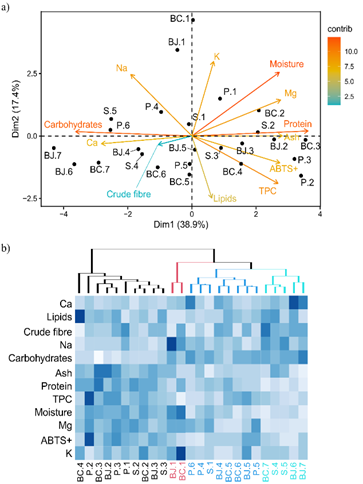
Figure 2 Principal component analysis (a) and heatmap (b) of quinoa leaves for varieties in each phenological stage.
CONCLUSIONS
Blanca Junín and Blanca Criolla reached complete phenological stages at 84 days, characterized by extensive ramification. On the other hand, Pasankalla and Salcedo had early phenological stages with shorter flowering times of 76 and 52 days, respectively. Quinoa leaves are a valuable raw material due to their high protein and fiber content and low calorie count. Most varieties reached maximum protein levels at the third phenological stage, making quinoa leaves a potential source for protein concentrates and isolates. In terms of micronutrients, quinoa leaves have high calcium concentrations, with Pasankalla and Blanca Junin having the highest levels. Additionally, quinoa leaves contain significant amounts of potassium and magnesium. The second phenological stage was found to have the highest levels of total phenolic compounds and antioxidant capacity in all quinoa varieties, with Pasankalla having particularly high values. It is concluded that quinoa leaves can be a plant-based protein ingredient, rich in fibre and minerals with an excellent antioxidant effect. The future investigations should be oriented to study the bioavailability of the nutrients and consumer acceptability of the products based on quinoa leaves.












 uBio
uBio 

